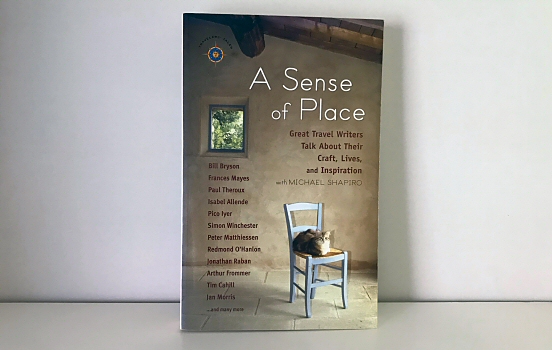This little gem has unfortunately been collecting dust on my shelf for a decade since I found it by accident on a sunny morning in San Francisco.

It’s sort of a meta book on travel writing, since it’s not really about traveling per se, but rather the craft in itself. Michael Shapiro travels around the world to interview several travel writers on various locations. The authors seem unusually relaxed in their interviews, perhaps due to Shapiro’s own open and friendly approach to the project. He seems to hold many of the authors as personal demi-gods, which makes the tone a lot different than if the interviews would have been conducted by any random journalist.
He meets up with Isabel Allende at her mansion near San Fransisco. One of my favorite books by Allende is Paula, which deals with the trauma of her dying daughter. The interview happened to turn into an honest conversation about death, since Shapiro’s own father had just passed away. The title actually refers to a discussion with Allende where they talk about how to describe a location using things as smell, texture, temperature, colors and more. The history, geography and topography can also help us understand a lot about a place.
Shapiro talks to Tim Cahill in his cabin north of Yellowstone. I remember a visit to the infamous bookstore Shakespeare and Company in Paris, where I bought a worn copy of Cahill’s classic book Road Fever. It gives lengthy details about his 15000 mile drive from Tierra del Fuego to northern Alaska which ended up in the Guinness Book of World Records.
Another pair of interviewed writers are Bill Bryson and Paul Theroux. Bill Bryson is well known for his humorous travel writing, but I was surprised when he described himself as a spy since he claims to be unable to interact with people. Unlike Paul Theroux, who is very skilled at getting conversations started in the most unlikely situations. In his classic The Great Railway Bazaar from 1975, even tedious endless train journeys seems like a breeze, with interesting people everywhere. But while the real Theroux comes off every bit as sarcastic in the interview as the voice from his books, Bryson seems like a really nice guy.
Arthur Frommer vividly recalls how his first book was born. At the age of 24, he was enlisted in the army and sent to Germany. During every available free time he traveled by night trains or using the free transport provided by the Air Force to visit all corners of Europe. His experiences resulted in the book The G.I.’s Guide to Traveling in Europe (1955), which was an instant hit.
Aside from the literary giants, I discovered some new gems. In particular I enjoyed the interview with Pico Iver, who I hadn’t heard of before. He seemed to be a very sympathetic person and I will definitely have a look at his books.
All in all, a quite enjoyable collection of interesting individuals. Some themes are however bound to be tediously repeated, as they are common in time and craft. For instance, the book was compiled in 2004 so the events of September 11 as well as the Iraq war and the Bush administration are often mentioned by the writers. Due to this and similar themes I would rather recommend that the chapters are read individually than all together at the same time.
Related posts
Comments
No comments yet.
Leave a reply